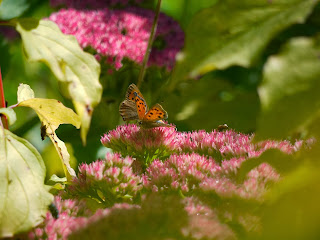21 September is traditionally the date of the autumn equinox, one of the four touchstones in the solar calendar that have dictated the rhythm of life for millennia. This year, and in this time zone (the quaintly named 'British Summer Time', or GMT/UTC +1 hour) the equinox actually occurs tomorrow, 22 September. A quick Google search pins it down even more precisely to 9.44 pm on Sunday, after which the nights will stretch out until we reach my favourite day of the year, the Winter Solstice, on or around 21 December. Then, a corner is turned and spring suddenly seems a tangible, if still-distant, prospect.
Signs of the equinox are all around. We awoke this morning to the familiar sharp call of a Dipper
Cinclus cinclus, typical birds of fast-flowing streams. Their predominantly black plumage, with a chestnut band on the belly, contrasts with a pure white throat and breast, making this one of the smartest of all British birds (see
http://www.rspb.org.uk/wildlife/birdguide/name/d/dipper/index.aspx). In recent years at least one Dipper has set up an autumn and winter territory along the former millstream that rushes through our garden, and it somehow seemed appropriate that we saw the first of the season today, on the eve of "official" autumn. It sat on a small wooden bridge, bobbing up and down on its strong pinkish legs, hopping from one handrail to the other, calling frequently in semi-display.
The orchard is dripping with Bramley
apples, the crab apple 'Red Sentinel' is studded with scarlet fruit, and
both the Persian ironwood
Parrotia persica 'Felicie' and
Euonymus europaeus 'Red Cascade', a cultivar of our native spindle, are starting to show their brilliant autumn colours.
 |
| Euonymus europaeus 'Red Cascade' |
 |
| Malus x robusta 'Red Sentinel' |
 |
| Parrotia persica 'Felicie' |
Late-morning I drove down to the nearby coast and watched small groups of migrating Swallows
Hirundo rustica – totalling some 300 in the space of an hour – arrive from the north, low over the sea, twittering excitedly as they made landfall and flying right past me to hurry on southwards. Still only at the very beginning of their epic trans-Saharan odyssey, they will track the sun's journey into the Southern Hemisphere, as far as South Africa, to reap the insect-laden riches of their second spring and summer of the year. As I wished the Swallows safe travels, the outflowing equinoctial spring tide surged round the rocks below me.
 |
| Adult Swallow – Photo © Richard Campey |
So tomorrow evening, at precisely 9.44 pm, I will raise a glass to the turning of the seasons and all that it means in the natural world.
Postscript
At 6.30 pm I heard Swallow alarm calls and looked up to see a tight-knit bunch of about 25 Swallows high over the garden, almost disappearing in the misty low cloud and drizzle. I think they must have been trying to roost in the tops of the conifers in the nearby plantation, but got spooked by something, perhaps a Sparrowhawk hunting under the cover of failing light.



































